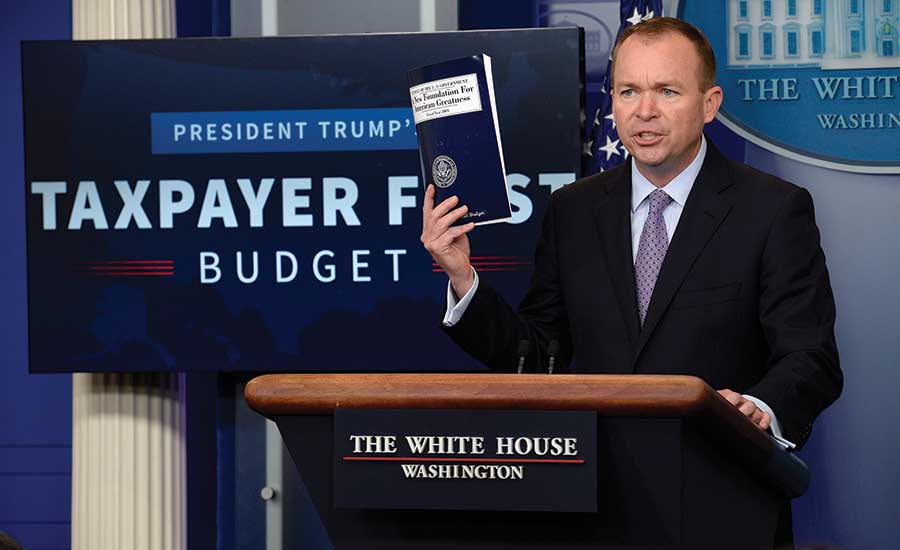President Trump’s fiscal 2018 budget proposal confirms that he will seek $200 billion in federal infrastructure funds over 10 years to spark several hundred million dollars more from non-federal sources. But the budget, released on May 23, doesn’t specify how the $200 billion would be split among agencies and notes that there would be only $5 billion in outlays from the initiative in 2018.
The budget says that, besides federal funds, Trump’s $1-trillion overall infrastructure “target” would include “incentivized non-federal funding” and “expedited projects that would not have happened but for the administration’s involvement.” For example, it cites the Keystone XL oil pipeline, whose price tag is $3.3 billion.
Apart from the infrastructure initiative, the new budget tracks closely with the outline the Office of Management and Budget unveiled in March. Overall, it seeks a $54- billion 2018 increase in defense funding, offset by $54 billion in non-defense cuts. Beyond 2018, the budget calls for a further 2% annual non-defense reduction.
Under Trump’s proposal, the Army Corps of Engineers civil-works program would be cut by 16%, to about $5 billion. Within the total, the Corps’ construction account would be slashed 46%, to $1 billion, and its operation-and-maintenance account would be pared by about 2%.
Steve Stockton, senior adviser at Dawson & Associates, Washington, D.C., says that in recent years, Congress has added about $1 bilion to past administrations' annual budget proposals for Corps civil works.
Stockton, a former Corps director of civil works, adds, "The president's budget is basically a proposal [of] where they're going to put their money. But then Congress says, 'Thank you for your suggestion. Now we're actually going to put the appropriations bill together.'"
EPA, DOT program cuts
The budget also recommends a $2.6-billion, or 31%, reduction for the Environmental Protection Agency. It proposes a cut of $330 million, or 30%, in the Superfund program. Within EPA's main water-infrastructure account, clean water state revolving funds would get $1.4 billion and drinking-water SRFs would receive $863 million—in both cases, the same amounts as in 2017.
The American Institute of Architects criticized the cuts at EPA, which AIA President Thomas Vonier said, would "eliminate successful and innovative programs, including Energy Star, which help to promote energy-efficient buildings and cities."
Trump’s plan would end federal funding of Federal Transit Administration capital grants for projects that lack grant agreements involving federal and non-federal agencies. It also would zero out the Transportation Investment Generating Economic Recovery (TIGER) grants.
"There are a lot of disappointments," says Steve Hall, American Council of Engineering Companies vice president for government affairs. Besides cuts in TIGER and transit capital grants and Corps civil works, Hall cites proposed reductions in Agriculture Dept. aid for rural water infrastructure and Housing and Urban Development Dept. community development block grants."There's...a lot of money taken out of domestic discretionary that hurts a lot of really good programs," he says.
Not all of the construction-program arrows point down. The Energy Dept.’s environmental management program would rise 5%, to $6.5 billion. The General Services Administration’s construction account for new buildings would get $790 million, more than triple its 2017 level. The 2018 highway obligation limit would rise slightly, to the 2015 FAST Act’s mark.
A border wall remains a Trump priority. For 2018, he is seeking $1.6 billion to construct 32 miles of new wall, 28 miles of levee wall and 14 additional miles of wall to replace existing fencing.
Stephen Sandherr, Associated General Contractors of America CEO, said in a statement, “As a policy document, this budget provides an important, and much-needed, first step in identifying the best ways to pay for needed improvements, and expansions, to our aging infrastructure.”
Highway Trust Fund treatment
Congressional Democrats and industry officials also point, with concern, to the budget’s future treatment of the Highway Trust Fund. For the years from 2021 through 2027, the budget assumes spending from the trust fund that reflect the fund’s income, primarily from the federal motor-fuels tax. Compared with current baseline figures, the budget shows Highway Trust Fund outlays would be down $95 billion.
The office of Senate Minority Leader Chuck Schumer (D-N.Y.) sent out a release saying that Trump’s budget amounts to a “net cut” in infrastructure spending, with reductions outweighing the president’s proposed $200 billion in new infrastructure dollars. Schumer said in a statement, “The fuzzy math and sleight of hand can’t hide the fact that the President’s $200 billion plan is more than wiped out by other cuts to key infrastructure programs.”
The Highway Trust Fund numbers account for nearly half of those reductions, Schumer’s office says.
The House Transportation and Infrastructure Committee’s top Democrat, Peter DeFazio (Ore.) also criticized the infrastructure portions of the Trump proposal, contending that it “slashes federal-aid highway, transit and highway safety guaranteed funding from the Highway Trust Fund by $95 billion over 10 years.”
But U.S. Dept. of Transportation officials object to calling the trust fund numbers “cuts”—Secretary Elaine Chao suggests the term "dropoff." They say the budget reflects the trust fund’s future picture if there is no change in its revenue stream.
A DOT official says that after the FAST Act expires in 2020, “the assumption is that revenues and spending will be equal in the out-years and that we will have another mechanism at that point to deal with the Highway Trust Fund.”
Another department official says, “It’s not passing judgment one way or the other for the out-years. It’s just an honest recognition of where we are and frankly, I think, a challenge for policy makers to start the process of thinking about how to fix that.”
David Bauer, American Road & Transportation Builders Association senior vice president for government relations, says, “This is clearly a proactive proposal to constrain spending to what the trust fund’s existing revenues could support.” Bauer adds, “There has been no evidence and there has been no congressional support for actually allowing that to happen.”
Congress starts its review
The budget focus now shifts to Capitol Hill, where congressional leaders are making clear they will produce their own spending measure. Senate Budget Committee Chairman Mike Enzi (R-Wyo.) said, “We will take a close look at [Trump’s] budget, but Congress … will ultimately decide what the nation’s fiscal priorities will be.”
OMB Director Mick Mulvaney said, “Do I expect them to adopt this 100%, wholeheartedly, without any change? Absolutely not. Do I expect them to work with the administration on trying to figure out places where we’re on the same page? Absolutely.”




